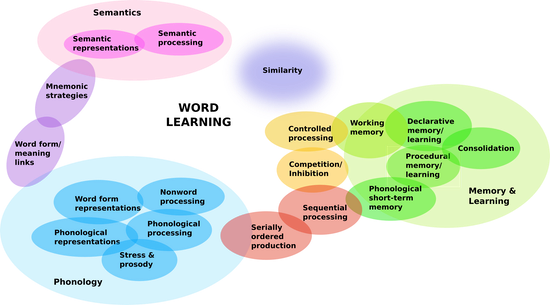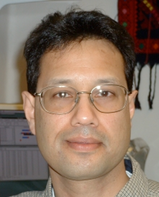
My research addresses a variety of aspects of cognitive processing centered around the question of how people learn new words. The schematic above illustrates this in a number of ways: first, it illustrates the centrality of human word learning to the questions addressed by my lab's program of research. Second, it depicts our view that the ability to learn new words lies at the intersection of a considerable variety of cognitive processes. Third, it indicates the fact that our research touches on numerous aspects of cognition.
Within this broad perspective, we have focussed particularly on two themes in our research investigations: understanding whether and how the processes underlying word learning relate to short-term and long-term memory systems; and understanding the nature and acquisition of phonological representations of words (that is, understanding how the sounds patterns of words are represented and learned).
For instance, based on computational considerations as well as neuropsychological evidence, I have proposed that the process of learning a single novel word can be fractionated into components that rely differentially on the two long-term memory systems termed procedural memory and declarative memory (Gupta & Dell, 1999; Gupta & Cohen, 2002; Gupta, 2012). In addition, a growing body of evidence indicates that human vocabulary learning, nonword repetition, and verbal short-term memory abilities are related in some way (e.g., Baddeley, Gathercole, & Papagno, 1998; Gathercole & Baddeley, 1993), and a good deal of research in my lab has aimed to uncover the details of processing mechanisms that could underlie these various abilities (e.g., Gupta & MacWhinney, 1993, 1995; Gupta, 1996a, 1996b; Gupta & MacWhinney, 1997; Gupta, 2003; Gupta, 2005; Gupta, Lipinski, Abbs, & Lin, 2005; Gupta, 2009; Gupta & Tisdale, 2009a, 2009b). As part of these investigations, we have made a number of explorations into the nature of long-term and short-term memory systems themselves (e.g., Gupta & Cohen, 2002; Gupta, Lipinski & Aktunc, 2005b).
Research focussed more on phonological representations has examined issues such as the effects of neighbohood structure on the processing and learning of novel words (Lipinski & Gupta, 2003, 2005; Lambert, Chang & Gupta, 2003; Newman, Samuelson, Gupta & Tisdale, 2008), and the learning of phonological representations themselves (Abbs, Gupta & Khetarpal, 2008; Graves, Grabowski, Mehta & Gupta, 2008; Gupta & Tisdale 2009b). Some of my earlier work also focussed on the theme of phonological representation, using neural network computational models to explore how the topology of the perceptual representation system could be shaped through exposure to the linguistic environment in early infancy (Gupta & Mozer, 1993), and to examine the relationship between linguistic theory and language processing, in the context of a particular sub-domain of phonology (Gupta & Touretzky, 1992, 1994).
These various lines of research have together led to the view depicted in the schematic above of how verbal short-term memory, linguistic processes and representations, and procedural and declarative memory systems are yoked together in order to learn new lexical items, and this serves as our general theoretical framework. It is also an important research goal to apply our theoretical framework to characterizing and understanding a variety of impairments of lexical processing and memory (e.g., Gupta, MacWhinney, Feldman & Sacco, 2003; Martin & Gupta, 2004; Abbs, Gupta, Tomblin & Lipinski, 2007). Overall, we adopt a multi-disciplinary approach to investigating issues of interest, attempting to combine experimental, computational, and neuroscientific methodologies, as illustrated by the research outlined above.
For more specific information about current research projects and about my lab, visit the Language and Memory Lab page.
